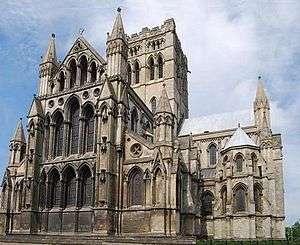George Gilbert Scott Jr.
George Gilbert Scott Jr. (8 October 1839 – 6 May 1897) was an English architect working in late Gothic and Queen Anne revival styles.
Known in later life as 'Middle Scott', he was the eldest son of Sir Gilbert Scott (George Gilbert Scott), and father of Sir Giles Gilbert Scott and Adrian Gilbert Scott, all also architects.
The last years of his life after the death of his father were marred by mental instability and excessive drinking. He died in the Midland Grand Hotel, St Pancras, a building designed by his father, of cirrhosis of the liver.
Biography

Scott was born on 8 October 1839, in London, eldest son of Sir Gilbert Scott (George Gilbert Scott) and Caroline Oldrid. After a scholarship at Eton College, he began training at his father's office. He later obtained a Cambridge University degree in moral sciences at Jesus College in 1866.[1]
During the 1860 and 1870s he worked for his father in his architectural practice.[2] He married Ellen King Sampson in the 1870s.[1]
He founded Watts & Company in 1874 along with two other leading 19th century architects: George Frederick Bodley (the architect of Washington National Cathedral) and Thomas Garner.
Among the buildings he designed was St John the Baptist Church, Norwich, which became a Roman Catholic cathedral.[3] He was also responsible for buildings in three of the University of Cambridge's colleges: Christ's, Pembroke and Peterhouse.[4] He masterminded the main buildings of Dulwich College in South London. Some of his finest works, the churches of All Hallows, Southwark (1877), and St Agnes, Kennington (1880) were destroyed by Second World War bombing.[5][6] His best remaining residential work is found in the Avenues area of Kingston upon Hull, which are in a Queen Anne revival style.[7] Much of his work was in the Queen Anne revival style, or in imitation of later Gothic architectural styles.[8]
After his father died in 1878 he became distant from the architectural business, and was supported by his inheritance.[3] In 1880 Scott became a Roman Catholic, to the shock of his family. The later part of his life saw his mental stability questioned, and in 1883 he was placed in Bethlem Hospital. A petition of his brothers and wife resulted in his being found of unsound mind in a public examination in 1884. He escaped to Rouen in France but, returning to England in 1885, he was confined to hospital again in 1885 and 1891-2.[9]
Scott died on 6 May 1897 from cirrhosis of the liver whilst in residence in the Midland Grand Hotel, St Pancras, which had been designed by his father, and was buried on 11 May 1897 at St John-at-Hampstead.[10]
He had six children, four of whom survived past childhood – two of his sons, Sir Giles Gilbert Scott and Adrian Gilbert Scott, went on to become noted architects.[10]
References
- Stamp 2004, para.1.
- Stamp 2004, para.2.
- Stamp 2004, para.3.
- "George Gilbert Scott, the younger", Cambridge 2000 project, retrieved October 2013 Check date values in:
|accessdate=(help) - "lost churches of southwark" (PDF).
- "All Hallows church, Southwark". Archived from the original on 9 May 2018.
- Urban Conservation and Design: Avenues/Pearson Park Conservation Area: Character Statement for the Avenues part of the above area (PDF), Government of the United Kingdom, archived from the original (PDF) on 4 April 2012, retrieved 14 August 2011
- Stamp 2004, para.3 & 4.
- Stamp 2004, paras.5 & 6.
- Stamp 2004, para.7.
Sources
- Stamp, Gavin (2004), "Scott, George Gilbert (1839–1897), architect and scholar", The Oxford Dictionary of National Biography, doi:10.1093/ref:odnb/60773CS1 maint: ref=harv (link)
- Stamp, Gavin (2002). An Architect of Promise: George Gilbert Scott Jr and the Late Gothic Revival. Shaun Tyas. ISBN 978-1-900289-51-1.
External links
| Wikimedia Commons has media related to George Gilbert Scott Junior. |
